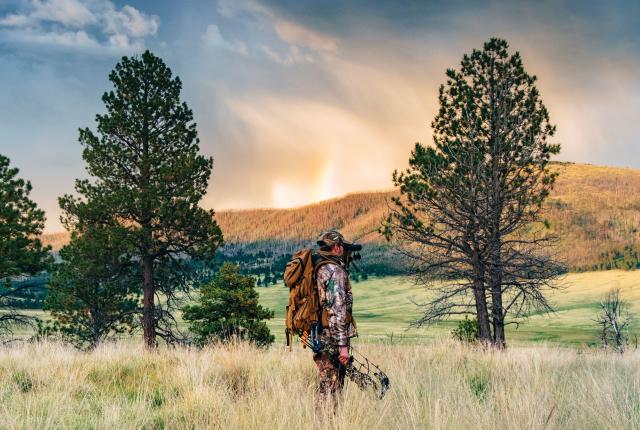Above: An elk hunter in the Valles Caldera National Preserve. Photographs by Andrew Kornylak.
WE ROSE HOURS BEFORE DAWN, loaded our packs into my Toyota Tacoma pickup, and headed toward Valles Caldera National Preserve, still shrouded in darkness. From the main gate, my hunting partner, Garrett VeneKlasen, and I couldn’t see the caldera’s iconic grassy bowl. But we could hear it. As soon as we stepped out of the truck, the eerie squeals of dozens of bull elk pierced the silence. Their primordial cries set our hunters’ hearts racing.
On most New Mexico elk hunts, you’re lucky to hear one elk bugling at the crack of dawn; often you don’t hear any. Now there were more than we could count. Whispering, partly so the animals wouldn’t hear us but mainly out of sheer awe, I said, “I think we hit the jackpot.”
Indeed, to even get chosen for an elk hunt in the Valles Caldera—for bow, rifle, or muzzleloader—is to win a lottery. Because of the enormous size of the elk herd, the world-class landscape, and the small number of hunters allowed in, Valles Caldera hosts some of the most sought-after public-land elk hunts in New Mexico, perhaps in the nation. More than 6,600 hunters applied for the preserve’s five most popular hunts in 2018. Only 90 of us drew licenses.
That doesn’t mean 90 of us hit our mark. It’s called “hunting” for a reason. You walk long miles, stop often, listen intently, scour the distance with binoculars, examine the ground for signs, climb uphill and down—all in the hope of harvesting an animal. Fewer than half of all elk hunters in New Mexico go home with meat, and odds are generally worse for those like me who hunt with a bow. A rifle hunter only needs to get within two or three football fields to shoot; a bowhunter must get within a few dozen yards.
“And getting to within 50 yards is only half the battle,” says a friend, Albuquerque bowhunter Dub Girand. From equipment troubles to shifting winds to simple bad luck, he says, “a lot of things can go wrong when you’re hunting elk.”
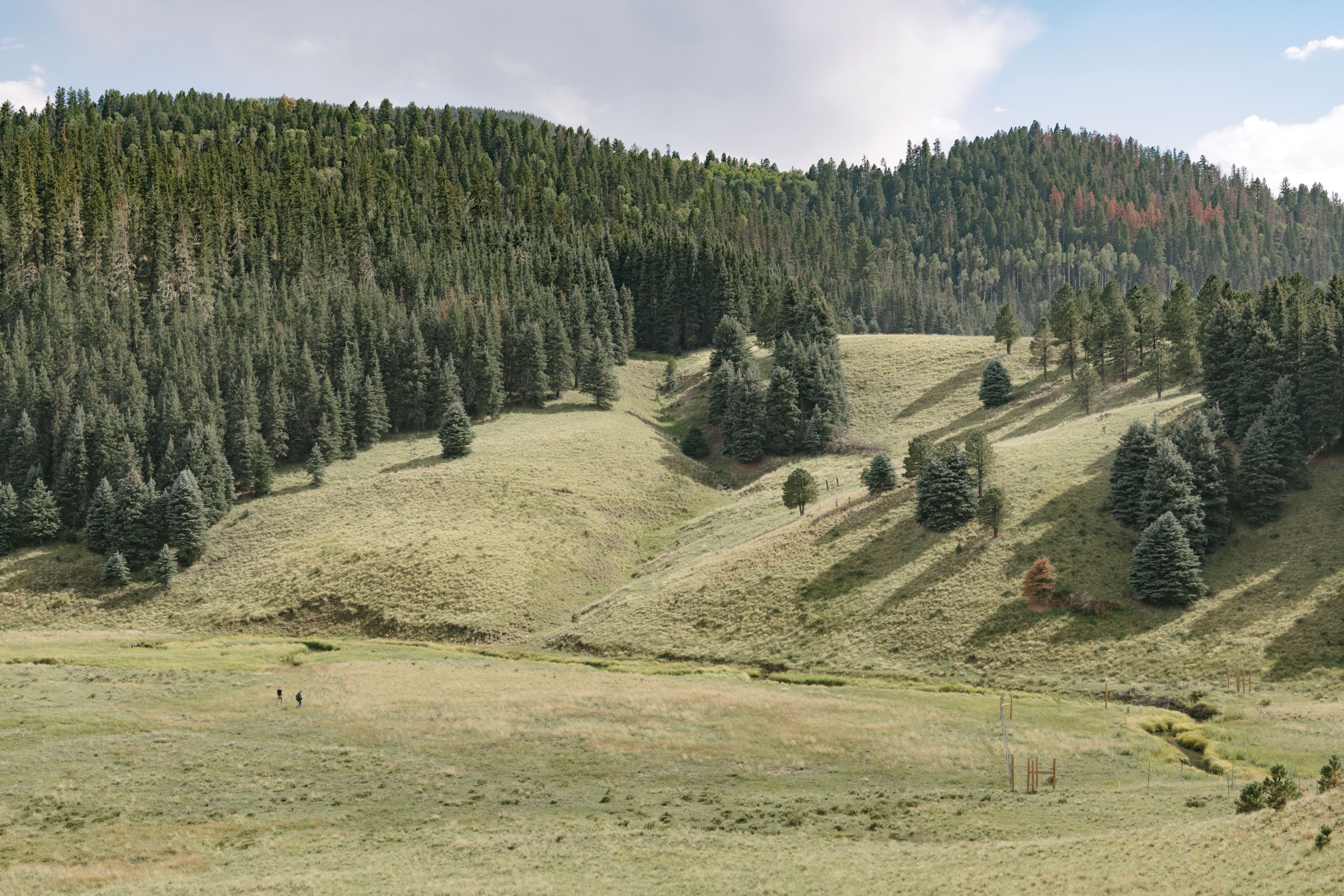 Above: Hunters take advantage of daylight to scout for evidence of elk.
Above: Hunters take advantage of daylight to scout for evidence of elk.
IT COMES AS A SURPRISE TO MANY, but elk are nocturnal animals. Generally, they spend most of the day bedded down in thick, dark timber high up the hillside, hidden from predators of all sorts. At dusk they mosey downhill to graze and drink. As dawn approaches, they head uphill again.
Since it’s legal to shoot only during daylight hours, Garrett and I typically woke at our Banco Bonito campsite—one of the perks of a Valles Caldera hunt—at 4:30 a.m., had coffee and a quick breakfast, drove to the preserve, and started hiking in the dark. To ensure we were ahead of the elk as they returned to their bedding sites, we generally climbed 750 to 1,000 feet before the sun nudged the horizon.
On that first morning, with the Jemez sky gradually turning from silver to salmon and apricot, several bulls bugled as they ambled in our direction. Archery hunts are scheduled in September, during the rut, when bulls “vie for the hearts of their female counterparts,” as the Rocky Mountain National Park website romanticizes it. Males bugle to attract cows’ attention and to warn other bulls to back off.
Experienced hunters use different types of calls to mimic the many sounds made by elk, and a good caller knows how to lure amorous bulls. Garrett, who did not draw an elk license but agreed to come along and call for me, deftly used a cow call, and a bull soon emerged from the brush. Elk have good eyesight, an excellent sense of smell, and, often, a suspicious streak, so it was no surprise the bull stopped 50 yards away and cast a wary eye in our direction.
Some hunters, armed with today’s extremely accurate compound bows, are confident shooting 60 yards or more. With my vintage McPherson compound, I’m comfortable only to 40 yards, so I held my arrow. If the action this morning was any indication, I figured that I could afford to wait. Soon enough, I’d learn how wrong I was.
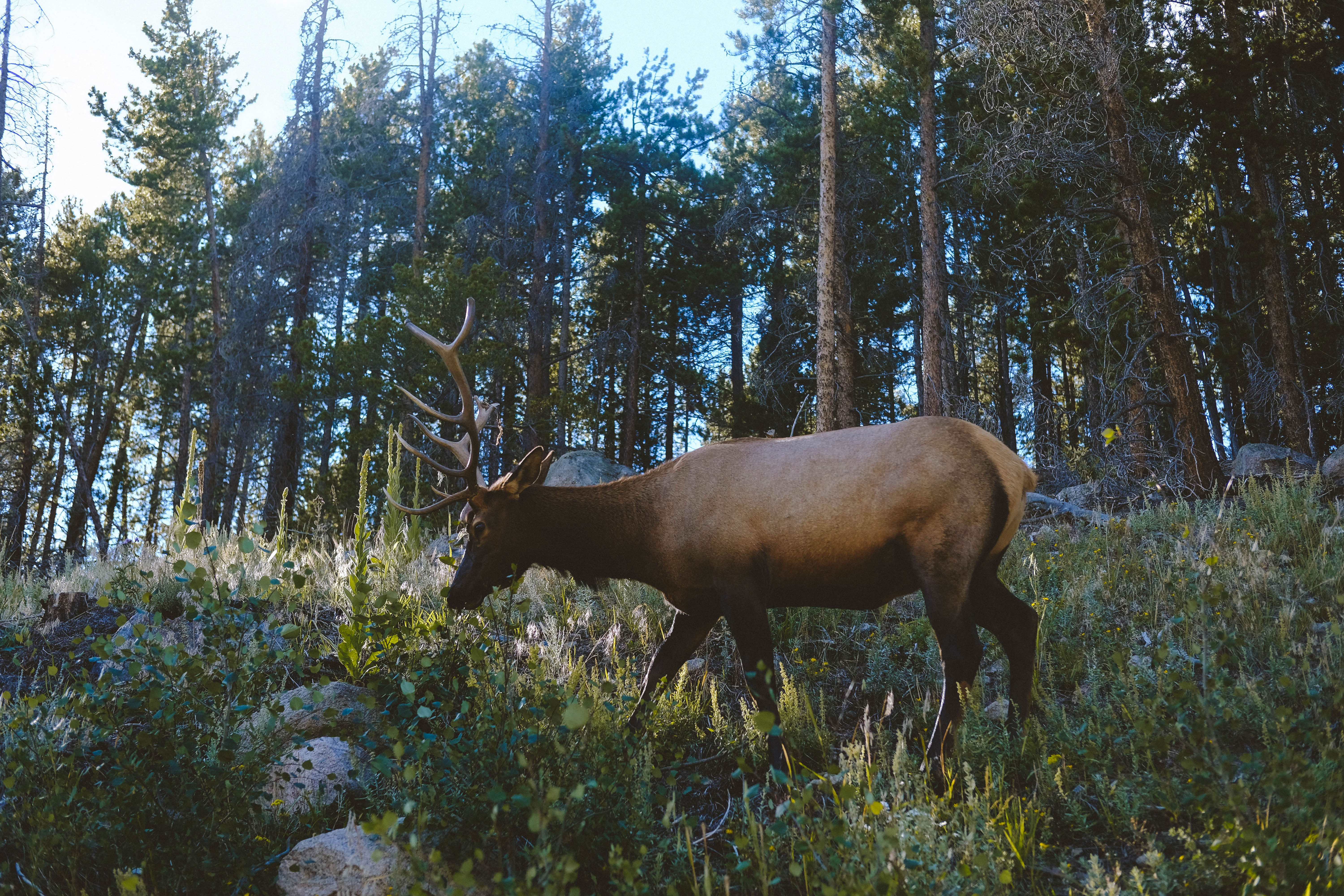 Above: An elk in the wild. Photograph by Revolver Creative Company/Unsplash.
Above: An elk in the wild. Photograph by Revolver Creative Company/Unsplash.
ELK ARE FOUND throughout New Mexico, but that was not always the case. By the time the state joined the Union, in 1912, one subspecies found only in the Southwest, the Merriam’s, was extinct, wiped out by commercial hunting and uncontrolled livestock grazing. In northern New Mexico, another subspecies, the Rocky Mountain elk, was nearly gone as well.
Many other game animals were on the ropes, too. Market hunters and habitat degradation had devastated mule deer, pronghorn, wild turkey, and desert bighorn sheep, among others. But in the early 1900s, sportsmen and -women all over the United States began working with lawmakers and scientists to rebuild depleted stocks of game and fish. Their tool kit, embodied in a set of principles known as the North American Model of Wildlife Conservation, included science-based management, stringent harvest levels, beefed-up law enforcement, and, when needed, transplanting animals from areas of abundance to ones of scarcity.
In northern New Mexico, Rocky Mountain elk from the Yellowstone region were introduced as early as 1910. Today the New Mexico Department of Game and Fish estimates the statewide elk population at 70,000 to 90,000. Roughly 7,000 live in the Jemez Mountains, including an estimated 2,000 to 2,500 in Valles Caldera National Preserve. Hunting pressure is carefully controlled to prevent individual herds from exceeding the carrying capacity of their habitat and to ensure they don’t become a headache—or worse—for landowners and motorists.
The number of Americans who hunt has been in steady decline over the past 50 years, a trend cheered by some who see hunting as cruel and no longer a subsistence necessity. Yet the hunting tradition continues. Many in New Mexico count it as a key element of their family heritage, going back in some cases centuries. Others, including me, hunt mainly for high-quality, sustainably harvested meat. All so-called consumptive users of wildlife play a crucial role in wildlife management. Hunter and angler license fees, along with the federal taxes we pay on hunting and fishing equipment, are the sole sources of revenue for managing wildlife in many states, including New Mexico. As hunting declines, so do the dollars available to manage all species of fish and game.
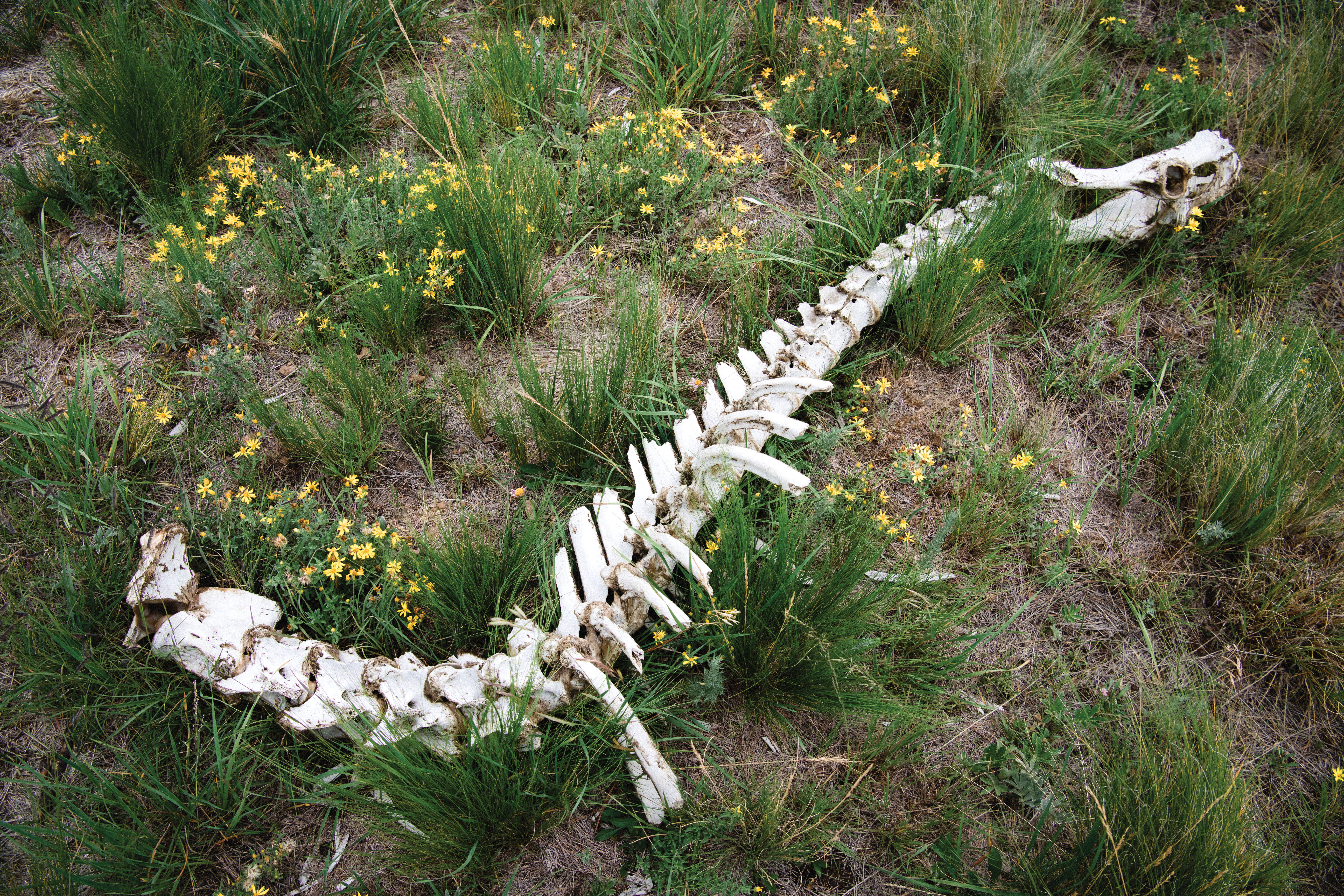 Above: The skeleton of a deer or an elk lies among the wildflowers.
Above: The skeleton of a deer or an elk lies among the wildflowers.
One look at the Valles Caldera and it’s obvious why elk have thrived in this corner of the Jemez. The grass is thick, the streams are crystal clear, the forests are chock-full of nutritious plants and dark timber, and human activity is carefully controlled. The animals we saw were not just healthy, but portly.
The preserve’s riches were audible that first morning, but on full display that afternoon. Garrett and I hoped to catch one bull on its way down at dusk. Instead, we saw not a trickle of elk, not a stream, but a veritable flood—easily 100 cows, calves, and bulls meandering to the grassy meadows below. We watched in awe, giddy at a sight straight out of an Outdoor Channel documentary.
At the end came three big, bugling bulls, though none were close enough for me to shoot. After they disappeared, we were practically shaking. Garrett, who grew up hunting elk in New Mexico and was a big-game guide for years, said simply, “I’ve never seen anything like it!”
I LEARNED TO CAMP, fish, and backpack while growing up in Albuquerque. Spending nearly 30 years in Alaska was like graduate school in my outdoor education. Yet I never hunted until I moved back to New Mexico, in 2005. I had been curious about trying hunting as a new outdoor adventure, then was lucky enough to fall in with a bunch of conservation-minded hunters who were happy to have another join their ranks. While hunter numbers are declining in general nationwide, one of the growing segments of the sport is people like me: “adult-onset hunters” who enjoy eating food they harvested themselves.
Read more: A primal hunting experience reaches a 21st-century conclusion.
My friends were mentors, cheerleaders, and guides, lending me the necessary equipment and taking me along on quail hunts, turkey hunts, and, eventually, my first elk hunt, in the Valle Vidal. Each adventure was part hiking, part hunting, and part hunter education. A few years later, I attended a certified hunter-education class, which more and more states require. What I learned in the class had already been instilled in me, but it bore repeating: Be ethical in all you do; respect the wildlife, the law, other hunters, and nearby landowners; be patient during the hunt and practice with your chosen weapon to ensure a quick kill; and never point a gun at something unless you plan to shoot it.
As I would learn, elk are, by almost any measure, the most highly desired big-game animal in New Mexico. Not only are they a challenge to hunt, but an adult bull can weigh 700 pounds or more and yield several hundred pounds of tasty, lean, and organic meat. Female elk, or cows, can reach 500 pounds. That’s a lot of fajitas, pot roast, burgers, and steaks.
The hunt starts with navigating a complicated licensing process. Many licenses (or “tags”) for hunting on public land are allocated through a lottery held every spring. People essentially put their name in a hat, and a lucky few win. In 2018, almost 77,000 individuals applied for an elk tag in New Mexico. Fewer than one in three were successful—which is why Garrett did not have a license, but I did.
The odds worsen for high-demand hunts like the Valles Caldera—about one in 50 for bowhunters, and less than one in 100 for some of the rifle hunts. Still, that’s better than it used to be.
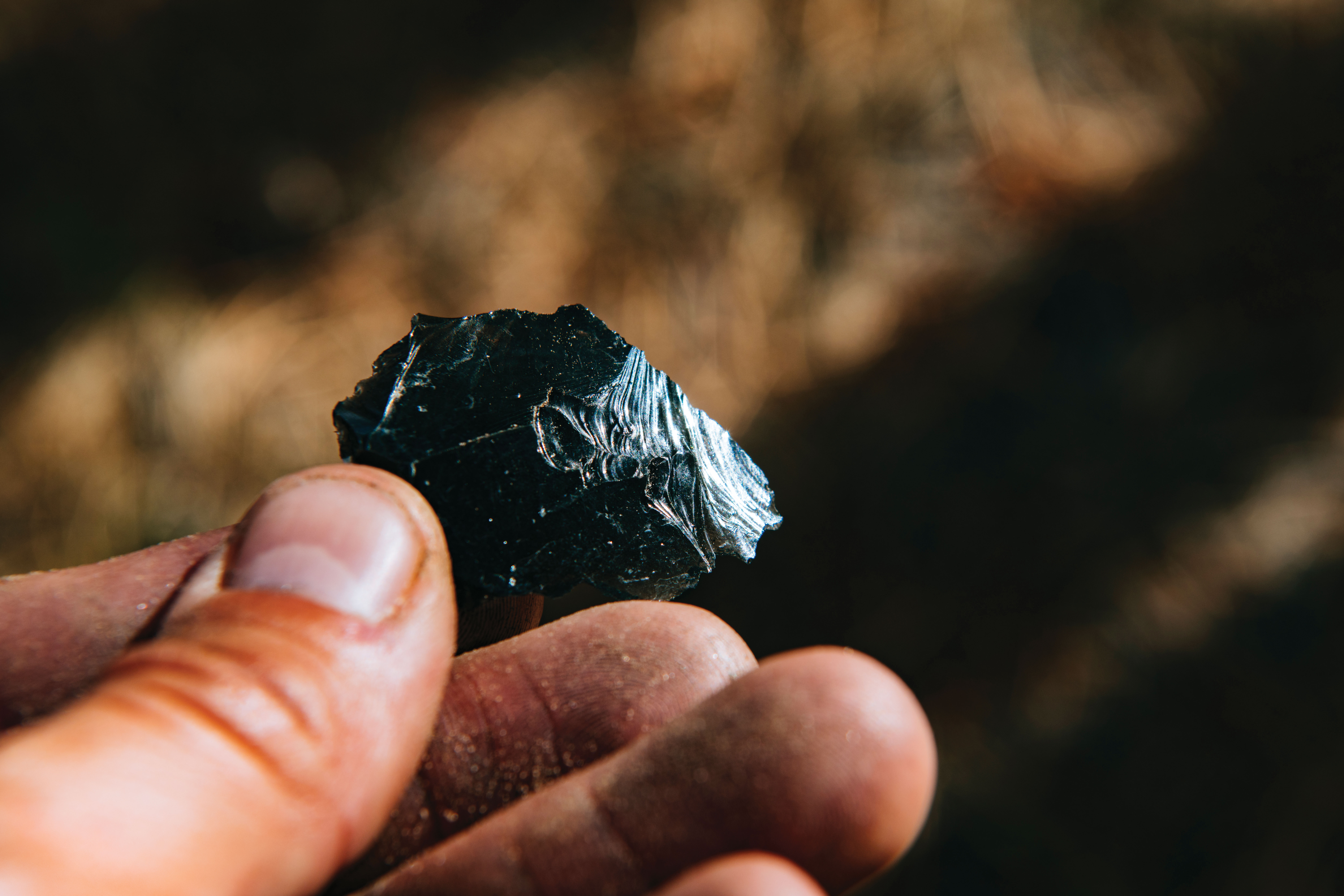 Above: An abundance of obsidian flakes speak to the land's volcanic past.
Above: An abundance of obsidian flakes speak to the land's volcanic past.
The enormous volcanic basin called Valles Caldera National Preserve was first visited by hunters some 11,000 years ago, which we know because they left their stone points behind. It was a traditional hunting ground for Native Americans until the mid-1800s, when the federal government ceded the land to heirs of the Baca family to settle a land grant dispute a hundred miles away in Las Vegas, New Mexico. In 2000, the U.S. government bought it for $101 million and embarked on a profit-making management plan that put hunting licenses beyond most people’s pocketbooks before finally turning the land over to the National Park Service in 2015.
Jemez Pueblo has pursued its own claim on the land in a case still working its way through the courts. For now, the site is an elk hunter’s mecca—a tough one, because motorized access is limited. As the preserve’s brochure says: “Our hunts are designed to pay homage to humans’ oldest relationship with animals.”
MY HUNT WAS SCHEDULED for the first 14 days of September 2018, but getting a kidney stone removed reduced it to just six days. Every morning, Garrett and I climbed uphill in the dark and soon heard bugling bulls coming our way. One morning, 100 or so elk marched into our meadow, then veered off to the east—toward Garrett and away from me. He lay in the grass as dozens of cows and calves grazed all around him, blissfully unaware of his camouflaged, six-foot-plus presence. A young bull bellowed just five yards away, while others butted heads nearby and half a dozen older bulls stood guard. None came within shooting distance, and soon they all wandered off.
Every day, even when the elk changed course or we chose the wrong drainage or the rain started or swirling winds blew our cover, the Valles Caldera amazed us, amused us, entertained us, and enthralled us. During the times when the elk were snoozing, we watched fat coyotes sauntering through the meadows and a badger patrolling one of the roads. We saw wild turkeys, hawks, and hummingbirds, and no end of bluebirds, flickers, robins, and ravens. One day Garrett spotted a wild hop plant growing on a hillside, and another day a short-horned lizard, better known as a horny toad. Some afternoons, we fished the Río San Antonio.
But we were there for elk, and early one morning it looked like my time had come. We heard bugling, and I positioned myself beside a thick Douglas fir, then watched as two dozen elk cows and calves paraded past me just yards away. All the while, a bull bugled and bellowed behind them, as if to say, “Get a move on, ladies!”
A lot of hunters dream of bringing home a huge set of antlers to hang on their wall, but I was there to fill my freezer with the best protein available. Before the hunt I told Garrett that I planned to shoot the first bull I could, regardless of size. In fact, I secretly hoped I could harvest a smaller, younger bull—you can’t eat antlers.
But when this loquacious bull lumbered into view, that dream morphed. Its vast, thick antlers seemed to go on forever, and I counted seven antler points on each side of its rack—a seven-by-seven bull, huge by anyone’s measure. As it stepped behind a large ponderosa, I had the cover I needed to draw my bow. When it walked back into the open, no more than 35 yards away, I had a perfect, easy broadside shot, the kind that elk hunters dream of, that most will never get, that many would pay tens of thousands of dollars for.
When I aimed, however, I discovered that the bow’s peep sight, which allows a hunter to accurately target an animal for a swift, clean kill, had twisted around. Instead of giving me a view of the elk through the lens, the sight blotted it out. In a split second, my hunter education kicked in. I couldn’t release the arrow, because I couldn’t see the elk. I could only watch, dumbfounded, as the colossal bull meandered uphill and out of sight.
 Above: The glory of the Valles Caldera.
Above: The glory of the Valles Caldera.
“What happened?” Garrett whispered when he came out of hiding. “That bull might have been the biggest taken in Valles Caldera this year!” I wanted to cry, but after telling him the story, I finally started laughing. Because, as all bowhunters know, stuff happens. Besides, I figured, we were in one of the elk capitals of New Mexico, with days left to hunt.
We did, indeed, continue to see and hear elk, sometimes one at a time, sometimes by the dozens and even hundreds. I was within 100 yards regularly, and 50 yards more than once, but never got the right shot. Once, after watching a medium-size bull for nearly an hour, it walked into range and I was seconds from releasing an arrow. Then, like something out of a comedy script, a group of elk I hadn’t even seen caught our scent and bolted, scaring my target too. ¡Adios!
Finally, as the light faded on my last day and we hiked silently back to the truck, I had to admit I was going home empty-handed. No fajitas, no antlers, nothing but sore feet and a few good stories. I had known, of course, that I might not take an elk, yet this was Valles Caldera. How could I not?
After sleeping in my own bed for a few days, however, I came to realize the real value of the hunt. It wasn’t the meat or the antlers, but a week immersed in one of the most beautiful places on earth—on public land to boot. To be there in the fall, when the aspens are turning gold and the elk are bugling; to watch the sky from dawn to dusk and see it switch from classic New Mexico blue to rousing thunderstorms and back; to hear the coyotes’ howl and the elk’s lonesome bugles drift for miles on the quiet air—that was my trophy. Everyone should be so lucky.

TAGGING IN
Elk hunters in New Mexico must have both a big-game hunting license ($15 for residents, $65 for others) plus an elk license ($58–$90 for residents, $548–$773 for others). Licenses are allocated through a lottery conducted every spring by the New Mexico Department of Game and Fish.
In the New Mexico big-game draw, residents receive 84 percent of licenses (called “tags”), nonresidents get 6 percent, and the remaining 10 percent are set aside for hunters who contract with an outfitter. New Mexico is the only state in the West with the outfitter guarantee.
In addition, New Mexico has the most liberal private-land hunting program, giving half of all elk licenses directly to landowners to sell, trade, or even not use. Those tags do not go through the draw but are given to landowners enrolled in the Elk Private Lands Use System. For more information on licenses, outfitters, hunter education courses, and conservation, go to wildlife.nm.state.us.
RECIPE FOR SUCCESS
Hunters like to say, “When the animal is down, the work begins.” Field dressing an elk and getting the meat back to the truck usually takes hours, sometimes days. If possible, you should hang the animal quarters in a cool place for a week to let them season, then butcher them and prepare and package the meat.
Every elk hunter has a favorite recipe. Here’s mine: Slice a prime cut of meat, such as backstrap, tenderloin, or roast, across the grain and into -inch steaks. Baste with a mixture of melted butter, olive oil, and fresh minced garlic, sprinkle the meat with salt and pepper, then grill over high heat for 3–4 minutes per side. Serve with mashed potatoes and enjoy. —JG


